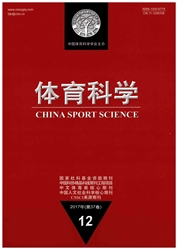

 中文摘要:
中文摘要:
目的:探讨心肌SarcKATP通道h6.2在运动预适应心肌保护效应中的变化以及与PKC的关系。方法:SD大鼠分对照组(C组)、力竭运动组(EE组)、运动预适应组(EP纽)、运动预适应+力竭运动组(EP+EE组)、PKC阻断剂+运动预适应组(CHE+EP)和PKC阻断剂十运动预适应+力竭运动组(CHE+EP+EE组)。一次大强度间歇跑台运动建立运动预适应模型,力竭跑台运动致大鼠心肌损伤。用原位杂交和实时荧光定量PCR法检测kr6.2mRNA变化,用免疫荧光和免疫印迹法检测kir6.2蛋白变化。结果:与C组比,EE组和EP组kir6.2mRNA无明显变化,而EE组kir6.2蛋白明显升高,EP组kir6.2蛋白明显下降。与EE组比,EP+EE组kir6.2mRNA无明显变化,1(ir6.2蛋白明显下降。与EP组比,CHE+EP组kir6.2mRNA明显降低,kir6.2蛋白明显升高。与EP+EE组比,CHE+EP+EE组kr6.2mRNA和kir6.2蛋白无明显变化。结论:在EP诱导的保护效应中,心肌SarCKATI,通道kir6.2mRNA水平未发生明显变化,而kir6.2蛋白水平明显降低,提示,心肌SarCKATP通道通过kir6.2蛋白水平的降低介导EP诱导的心肌保护效应。PKC对心肌SarcKare通道的表达具有调控作用。
 英文摘要:
英文摘要:
Objective= To study the changes of the Pore-Forming Subunit kir6. 2 of myocardial sarcolernmal ATP-sensitive potassium (SarCKATe) channels in myocardial protection of exercise preconditioning (EP) and the relations with protein kianse C (PKC). Methods: SD rats were divided into control group ( C), EE group, EP group, EP + EE group, CHE + EP group and CHE+EP+ EE group. By using once heavy intensity interval treadmill running, this paper es- tablishes EP model, and exhaustive exercise on treadmill to induce rats myocardial injury. In-si- tu hybridization and real-time fluorescence quantitative PCR methods were used to detect chan- ges of kir6. 2 rnRNA. Immunofluorescence and westten blotting methods were used to detect changes of kir6. 2 protein. Results: Compared with group C, there is no significant change of kir6.2 MRNA in group EE and EP, while kir6. 2 protein significantly increased in group EE and significantly decreased in group EP. Compared with group EE, no significant changes of kit6.2 mRNA in group EP + EE, kit6. 2 protein in group EPq-EE significantly decreased. Compared with group EP, kir6. 2 mRNA significantly decreased in group CHE+EP, kir6. 2 protein significantly increased in group CHE+EP. Compared with group EP+ EE, there is no significant changes of kir6. 2 mRNA and kir6. 2 protein in group CHE+EP+EE. Conclu- sion:In myocardial protection induced by EP, kir6. 2 mRNA did not changed significantly, while kit6.2 protein decreased significantly, which demonstrated myocardial SarCKATP channels mediated myocardial protection induced by EP through kir6.2 protein decreased. PKC can reg- ulate expression of myocardial SarcKATP channels.
 同期刊论文项目
同期刊论文项目
 同项目期刊论文
同项目期刊论文
 期刊信息
期刊信息
